Select File
> Auto Send Options > Auto Send Modes from the main
EBMS menu to open the following list:
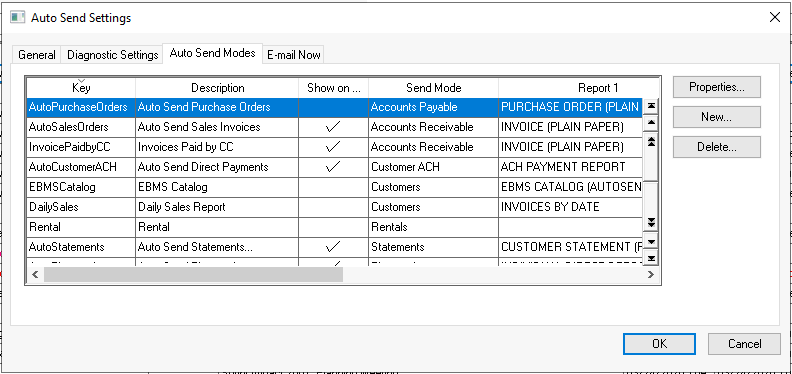
Purchase orders can be automatically sent as a batch to the vendor at the end of the day or sent individually from the purchase order window.
Batch - EBMS will automatically send a copy of the purchase order to a vendor's office whenever a document is created or processed. This method is useful in sending a copy of the document to the correct person within the office rather than relying on the printed invoice being hand delivered or mailed. E-mailing a document also saves postage and handling labor.
Individually - Purchase orders can be sent individually from the invoice menu using hot keys.
Command Line - A purchase order sent using an advanced command line function. This option is normally used by IT personnel or EBMS consultants to automate a process.
Complete the following steps to setup a Auto Send Mode:
Select File
> Auto Send Options > Auto Send Modes from the main
EBMS menu to open the following list:

Click the New button
to create a new Auto Send Mode and
open the following dialog or select the Accounts
Payable Auto Send Mode and click the Properties button.
Continue with step 6 if the mode has already been created:
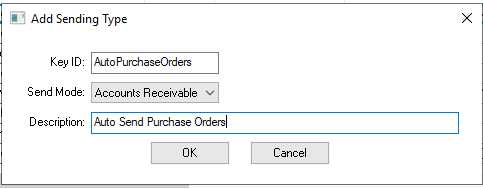
Each Auto Send Mode requires a unique Key Id. This Key ID should be a simple descriptive code that does not include spaces or symbols.
Select the Accounts Payable Send Mode option as shown above.
Enter a short Description of the auto send mode type. This description should clearly describe the mode process. Note that this text is used as the EBMS menu label. Click OK to continue.
Select File
> Auto Send Options > Auto Send Modes > AutoPurchaseOrders
> Properties from the main EBMS menu as show below:
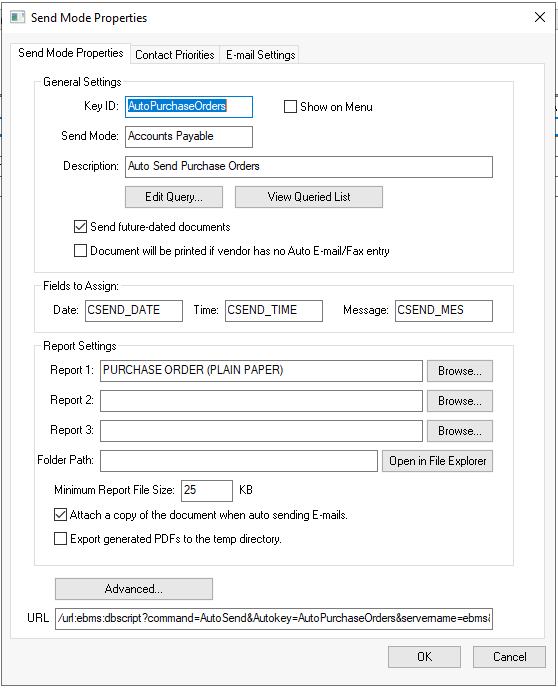
Select the Show on Menu option to make this feature appear on the main EBMS Expenses menu.
Click on the Edit Query button to select the group of purchase orders or invoices to be sent. Status <> "U" - This option would not send a purchase order until the invoice is processed. Note that the Status field of an invoice is set to 'U" until it is processed. Review the Standard Features > dBase Expressions section of the Main documentation for more details on creating Query expressions.
Click the View Queried
List to view all purchase orders that will be sent based
on the current query setting as shown below:

The Current Queried List lists all sales orders or invoices that match the query that have not been previously sent. The Send Date within the sales invoice must be blank to show on this list.
Click the Purge button to populate the Send Date for all invoices listed, removing them from the query. Use the Purge button to remove past invoices from the query. A purge is often required when a new query is created. Click the Close button.
Enable the Send Future-dated documents option to send all documents when they are created even if they are dated in the future. Otherwise Auto Send will wait to send till the document date arrives.
Enable the Document will be printed if vendor has no Auto E-mail/Fax entry option to print purchase orders for vendors without the settings required to email a purchase order. Review the following Vendor Configuration setting for instructions on setting these options within a vendor.
Maintain the default values within the Fields to Assign settings since they are advanced settings.
Enter the desired purchase order or invoice report into Report Settings: This Report should be a purchase order or invoice form. Contact your EBMS consultant for information on custom reports needed for this process.
The Minimum Report File Size setting: This feature is used to stop any sends on export files that are below a certain file size.
Enable the Attach a copy of the document when auto sending E-mails option to attach a PDF file that is formatted for the vendor to print. Disable this option to only communicate and not include a copy of the PO.
Click on the Advanced button
to configure the following settings:
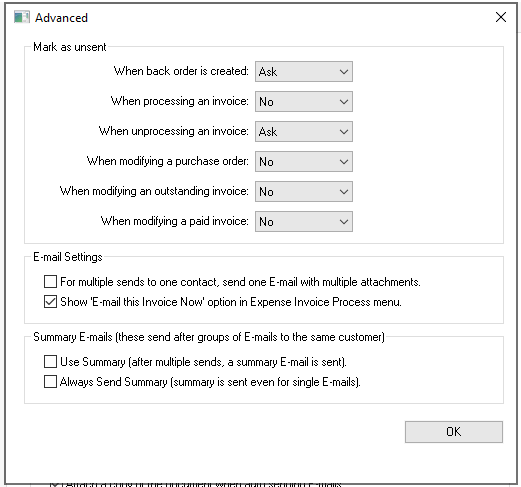
Configure the Mark as unsent options to change the status after a document has already been sent. For example, the When processing an invoice is set to Ask the system will prompt the user only when the invoice is being reprocessed.
Enable the For multiple sends to one contact, send one E-mail with multiple attachments option to group attachments for an individual customer into one E-mail. A separate E-mail will be generated for each document if this option is disabled.
Enable the She 'E-main this Invoice Now' option in Expense Invoice Process menu option to enable the user to use the Auto Send process through the server from the invoice menu.
Enable the Use Summary (after multiple sends, a summary E-mail is sent) option to send a summary to the specified Summary Recipient after a group of E-mails have been sent to a single customer. Review the E-mail Settings details within [Sales] CRM > Auto Send > General Setup Instructions for more information about the Summary Recipient setting.
Disable the Always Send Summary (summary is sent even to single E-mails) option if a summary is not required if the customer only received one e-mail. This setting has no effect if the previous Use Summary option is disabled. Click OK to save.
Click on the Contract Priorities tab to enter the recipient options. Review CRM > AutoSend > Contact Priorities for configuration details on these important recipient settings.
Complete one of the following methods to launch the process to auto send a batch of sales orders or invoice:
By selecting Sales > Auto Send Sales Invoices from the main EBMS menu if the Show on menu is enabled
Automatically sent using the Task Scheduler App: Use the URL text located at the bottom of this dialog to configure the Task Scheduler App. Review [Main] Technical > Automate using Task Scheduler App for instructions to send purchase orders on a daily basis.
By default, all Purchase Orders that were not yet sent (that have no value in the Sent Date field under Advanced Options) and are unprocessed will be sent.
Contact information must be set up for all the vendors before documents are sent. Complete the following steps
Go to Expenses > Vendor from
the main EBMS menu and open a vendor record. Click on the Contacts tab to view
the Contact Information as
shown below:

Select the Auto E-mail or Auto Fax entry label by clicking on the right arrow. The Auto Send module will ignore any other contact information. Copy the fax number before changing the heading if you are changing the label for a Fax entry to Auto Fax. The change will erase the fax number. Then paste the original number into the Auto Fax field. When using an E-mail to Fax system (a setting in General Settings), note that this Fax number will be translated into an E-mail address and processed as an E-mail. For more information on Contact Information see the Expenses > Vendors > Changing Vendor Information section of the Main documentation.
Review the Test Mode section for a way to put the system in test mode to determine if the setting options are setup properly.
Launch the Auto Send feature by selecting Expenses > Auto Send Purchase Orders from the main EBMS menu. When the process is started, it will cycle through the orders that are to be sent based on the setting described in the Test Mode section. A progress bar showing the status of the send process will appear and can run unattended, as no user input should be necessary.
As the system handles each order, it will export a report in PDF format to the Export Folder. This PDF file with then be attached to an e-mail or fax and sent to the vendor. If the customer does not have any Auto E-mail or Auto Fax entries in their contact information, the system will either ignore the order, or it will print it depending on your setup in General Settings, described in the Test Mode section.
Select View > Advanced Options from
the purchase order menu of an expense invoice and click on the Auto Send Status tab to view
the status of the Auto Send:
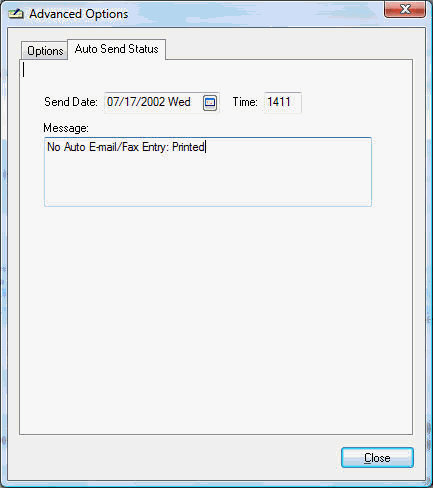
The system will mark the item with the date, time, and a message with the results after the Auto Send process is completed. This useful information gives the user details about the handling of a document by the Auto Send system. Simply eliminate the Send Date value from the document to send the document again.
Continue with the following section to send purchase orders individually rather than a batch
Review the Individually Sending Documents section for more details.